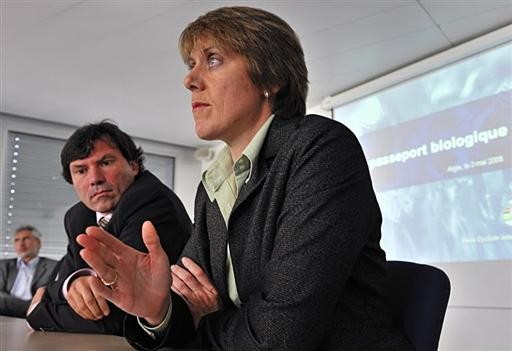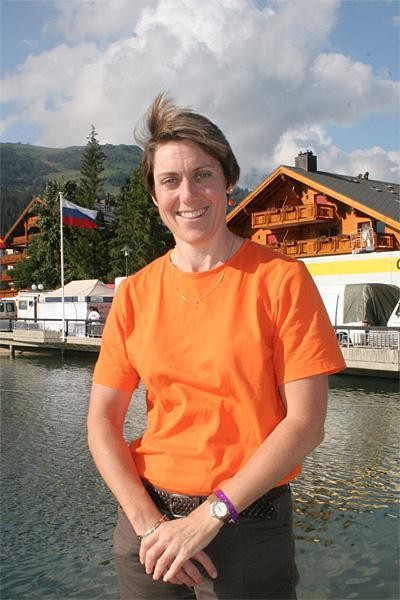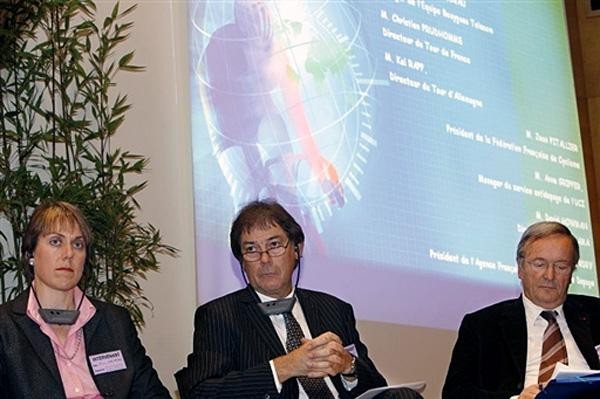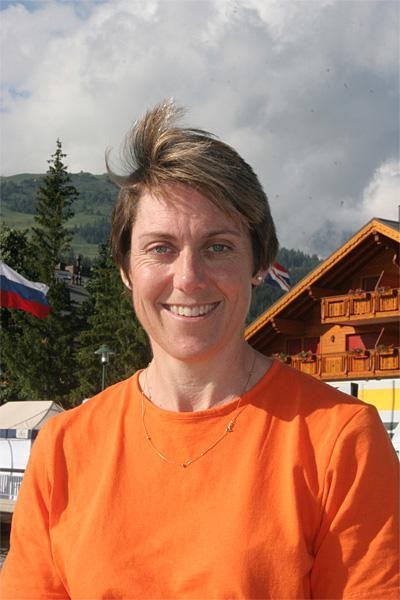Passport to a clean sport
With riders like Riccardo Riccò making it to the Tour de France still bold enough to use new...




An interview with Anne Gripper, November 12, 2008
International Cycling Union (UCI) anti-doping head Anne Gripper has come under pressure from anti-doping advocates who wish to see the organisation's new biological passport programme begin to catch cheaters. Cyclingnews' Bruce Hildenbrand caught up with the Australian to find out about the status of the groundbreaking anti-doping effort.
With riders like Riccardo Riccò making it to the Tour de France still bold enough to use new versions of EPO, the UCI's biological passport is seen as the one system which should deter riders from doping. However, even though the agency has collected enough data on the ProTour and wild card team riders to generate complete profiles, and passed a "no start rule" for riders with suspicious values, no rider has even been kept out of competition or punished for doping based on the passport data.
The UCI's anti-doping head Anne Gripper understands that people are anxious to see action. "I know it is a little bit frustrating that we have gotten to this point and haven't actually opened any cases," Gripper said of her less than year-old system. "But it is a new ground-breaking program. We have to be really careful, really cautious that when we do open some cases they stand up to the legal and scientific scrutiny that they will definitely be subjected to.
"We want these first cases to stand up in court so we are prepared to take just a little bit extra time to ensure that we have got the level of evidence we need rather than rushing in and having cases that don't stand up and therefore potentially undermine the whole program. I realize there is a little bit of frustration out there as to why we haven't been able to proceed so far, but we are just being safe rather than sorry at this point. We have invested too much to take risks at this point."
Getting started
Gripper has overseen the implementation of the passport program, which was only approved just one year ago. The Australian's first goal was the complex task of tracking hundreds of riders' whereabouts over the course of the year so they could be located for out-of-competition controls. "That really was our first task to train the riders and the teams on how they should do that," Gripper described. "The riders are using a program called ADAMS (Anti-doping Administration Management System) which is a program which has been created and maintained by WADA."
Get The Leadout Newsletter
The latest race content, interviews, features, reviews and expert buying guides, direct to your inbox!
"It's hard to keep making changes whenever there is a change in your [rider's] schedule. We have been very happy with the way they have done that. They are keeping their whereabouts up to date pretty well, actually," she said.
The UCI decided to focus its efforts first on the ProTour and wild card Professional Continental teams which would be participating in the sport's most prestigious events – a total of 854 riders.
The next step was to collect multiple blood and urine samples from all 854 riders to generate the blood profile which will be analysed to detect evidence of doping. "We had plans to collect lots of blood tests on the riders, both out-of-competition and what we call pre-competition which is immediately before a race. Also urine [tests] out-of-competition and the urine would have an EPO analysis on them as well. We have collected a lot of samples this year – as of the end of September it was 6,500 samples."
Once the samples were collected, Gripper said they had to ensure that all of the laboratories which would be testing the samples did the analysis in the exact same way. They accredited ten laboratories to handle the testing. "[The labs] are accredited through the Swiss Center for Quality Control. Six of those labs are also WADA labs, which are part of the WADA network. We have four additional labs which were originally accredited by the UCI as part of our regional blood testing program that we used to conduct before events."
Finally, the data generated by the testing labs will be analysed to see if there is evidence of doping in any of the riders' profiles. A statistical model was developed by the Lausanne laboratory in order to interpret the results. "It is the famous Bayesian statistical model. We had to make sure that was working," Gripper explained. "The Bayesian statistical model is a concept used in forensic science, criminal investigations, it is a statistical method that looks on building up enough evidence to reach a certain level of certainty."
Certainty is key
Although pressure is mounting to have potential cheaters outed based on the blood parameters compiled by the UCI, Gripper explained that her agency must proceed with caution and absolute certainty if this new paradigm in the fight against doping is going to succeed. The UCI has a panel of nine experts who examine the profiles of the riders and who will make recommendations based upon what they see.
"What we have been able to do it to produce at least a blood profile on all the riders that are in the program, and those profiles have now been sent to our group [of experts]," she said. "We are now at the point where the experts have reviewed all the blood profiles and we are following up to get what we call full documentation packages on some of those profiles. That further information will be sent to the experts and they will then make a recommendation to the UCI as to whether we should open cases against those riders based on their profiles."
Gripper emphasized that any potential doping case would be based on a novel concept: the interpretation of an athlete's blood and urine profiles which can indicate doping rather than the more traditional method of directly detecting a doping substance in an athlete's bodily fluids. "These will be the first ever cases opened based on an indirect detection method. Indirect in that we don't get a nice piece of paper from the lab saying they found EPO or they found steroids."
The key is the confidence that this panel of experts have based on the statistical analysis of the data. "It is actually using [a rider's] profile and interpreting that to say 'yes, we are more than 99.9% percent confident that this rider is doping'."
Should the experts find a suspicious profile, the UCI can then follow the procedures used for a traditional doping positive. "We will open up a disciplinary procedure and we will expect that the hearing body imposes a two-year sanction based on the breaking of the UCI anti-doping rules. It will be based on the use of a prohibited method rather than a prohibitive substance. Under the prohibited list is nine classes of substances and three methods and this would be one of the methods, the artificial enhancement of oxygen transfer.
"We won't know what they have done; whether they have taken EPO or CERA or used their own blood or used someone else's blood, but we will know that their profile shows us that they have artificially increased their oxygen carrying capacity. That is another fundamental shift in how anti-doping has been run before."
Two keys to detect doping
The UCI's passport program looks at eleven separate blood parameters for evidence of doping, Gripper said, but there are two major values which form the basis of the profile. "Within the blood profiling we are using two key parameters to develop the actual profile. Hemoglobin is one, and the other one is what we call 'off score' which is a calculation based on hemoglobin percentage of reticulocytes which gives you a percentage of the young, new, blood cells.
"The profile is setup to detect any form of blood manipulation. That is autologous or homologous blood transfusions, or the use of EPO or EPO-type products that boost the oxygen carrying capacity of the blood. Dynepo, Arnesp, CERA and all the thousands of biosimilars that are being produced around the world."
The rest of the data, Gripper said, are used to "take a deeper look at the profile of the rider", but those two key parameters are used to create a visual representation in the form of a graph which can show evidence of doping.
The keys to success
In the upcoming season, riders will be required to be a part of the biological passport programme in order to participate in the races on the UCI's "world calendar" (ProTour races and the "Historic" races which are run by the Grand Tour organisers).
Gripper said the teams must fulfil three obligations. "They need to be financially contributing. They need to be providing practical support. They need to be publicly supportive of the program as well. The key things are paying and assisting their riders to fulfill their responsibility."
Paying into the programme is especially important considering the cost of each control, which can be extremely vairable. "For a true out-of-competition test, if you have to go to the outlying parts of Kazakhstan to take a sample and ship it back to a lab it is much more expensive than picking up a sample from Fabian Cancellara, for instance, who lives five minutes away from the Swiss anti-doping office," Gripper explained.
The average cost for an out-of-competition test ranges from €300-2,000, depending on where and how the samples have to be collected. "The major part of that cost at the moment is in the transport of blood. Blood is really difficult to transport. It has to be shipped withing 36 hours and within a temperature of between 4 and 12 degrees celsius. Blood is really difficult to transport so the sample is fit for analysis when it arrives at the lab."
When it comes to budget, the money comes not just from the teams themselves, but also the ProTour event organisers, Grand Tour organisers, as well as the UCI and WADA and, surprisingly, the riders themselves. "The riders themselves ... contribute a portion of their prize money," Gripper said. "We haven't quite worked out the budget for next year, but this year, certainly the teams have paid the majority of the costs of the biological passports. The UCI makes a contribution and WADA made a big contribution to the start of the program by funding the research and they provide us with services during the year in helping us set up systems that can manage the profiling."
Support of teams and riders
The teams have been quite supportive of the programme, Gripper noted. "The teams have been the lifeblood of this program. We couldn't have done it without the teams. They really have been behind the program for the whole time. They have really encouraged their riders to be compliant with all aspects of their responsibilities."
"The teams had a breakthrough in August of last year when they met to discuss what they should do on an internal basis to run their own internal anti-doping programs. It was at that meeting in the Netherlands someone came up with the idea, 'why don't we combine all our resources and run a program that is consistent across the teams' and then someone else said 'why don't we get the UCI to coordinate it'."
"For me that was one of the best days of my working life here at the UCI. Since that time in August of last year the teams have really committed to it and made an investment into making it a success."
Gripper clarified that these were the ProTour teams asking for help, and said that the response of the Professional Continental teams has been a little bit more varied. "Some have been very, very supportive and others have been very reluctant because of the financial aspects and just a little bit of uncertainty as to whether they want their riders to be subjected to this level of scrutiny."
"I think some of the Professional Continental teams have a looser structure. They don't have quite as much control over their riders so that probably has some part to play."
Gripper added that the riders have been supportive about what can be an invasive process. "Unlike other sports where out-of-competition testing can be done at a swimming pool or a football field or a basketball court there is a big chunk of the day where our riders are training and we can't test them so this means we have to test them at home.
"I think we have to acknowledge that this puts a strain on not just them [the riders] but their families to bear that burden as well. But, I have been amazed as to how well the riders have received this concept. There were a few grumbles in the early days and a few issues, but now I think they just see it as part of their job."